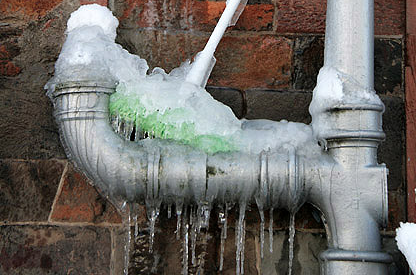Avoiding Frozen Plumbing in Winter: Pro Tips
Avoiding Frozen Plumbing in Winter: Pro Tips
Blog Article
How do you really feel with regards to 6 Ways to Prevent Frozen Pipes?

Winter can damage your plumbing, especially by freezing pipes. Right here's how to avoid it from happening and what to do if it does.
Introduction
As temperature levels decline, the danger of icy pipes increases, potentially causing costly repair services and water damages. Understanding how to prevent icy pipelines is vital for house owners in cool climates.
Prevention Tips
Insulating susceptible pipes
Wrap pipes in insulation sleeves or use heat tape to shield them from freezing temperatures. Focus on pipes in unheated or external areas of the home.
Heating strategies
Maintain indoor rooms effectively heated up, especially locations with pipes. Open up cupboard doors to enable warm air to circulate around pipelines under sinks.
Exactly how to identify icy pipes
Search for reduced water flow from taps, unusual odors or sounds from pipes, and noticeable frost on revealed pipes.
Long-Term Solutions
Structural adjustments
Take into consideration rerouting pipes far from exterior wall surfaces or unheated areas. Add added insulation to attics, cellars, and crawl spaces.
Upgrading insulation
Buy premium insulation for pipes, attics, and wall surfaces. Correct insulation aids keep regular temperature levels and lowers the danger of icy pipelines.
Protecting Outdoor Pipes
Yard pipes and outside taps
Separate and drain yard hoses prior to winter season. Set up frost-proof spigots or cover outside faucets with protected caps.
Comprehending Icy Pipes
What triggers pipes to ice up?
Pipelines freeze when revealed to temperatures below 32 ° F (0 ° C) for expanded durations. As water inside the pipelines ices up, it expands, putting pressure on the pipe walls and possibly creating them to rupture.
Risks and damages
Frozen pipes can bring about water supply disruptions, property damage, and costly repair work. Ruptured pipes can flood homes and trigger extensive structural damage.
Indications of Frozen Piping
Recognizing frozen pipelines early can avoid them from rupturing.
What to Do If Your Pipelines Freeze
Immediate actions to take
If you suspect frozen pipes, keep faucets open to soothe pressure as the ice thaws. Utilize a hairdryer or towels taken in warm water to thaw pipelines gradually.
Final thought
Stopping icy pipes requires positive steps and fast actions. By understanding the reasons, signs, and preventive measures, home owners can protect their pipes during winter.
6 Proven Ways to Prevent Frozen Pipes and Protect Your Home
Disconnect and Drain Garden Hoses
Before winter arrives, start by disconnecting your garden hoses and draining any remaining water. Close the shut-off valves that supply outdoor hose bibs and leave the outdoor faucet open to allow any residual water to drain. For extra protection, consider using faucet covers throughout the colder months. It’s also important to drain water from any sprinkler supply lines following the manufacturer’s directions.
Insulate Exposed Pipes
Insulating your pipes is an effective way to prevent freezing. Pipe insulation is readily available at home improvement stores and is relatively inexpensive. Pay close attention to pipes in unheated areas such as the attic, basement, crawl spaces, or garage. Apply foam insulation generously to create a buffer against the cold. You can also wrap your pipes in heat tape or thermostat-controlled heat cables for added warmth.
Seal Air Leaks
Inspect your home for any cracks or openings that could let in cold air. Seal any holes around the piping in interior or exterior walls, as well as the sill plates where your home rests on its foundation. Additionally, make sure to keep your garage door closed unless you’re entering or exiting. Leaving it open creates a significant air leak that can lead to frozen pipes.
Allow Warm Air Circulation
During cold snaps, it’s essential to allow warm air to circulate evenly throughout your home. Leave interior doors ajar to promote better airflow. Open kitchen and bathroom cabinets to help distribute heat consistently around the rooms. If you have small children or pets, be sure to remove any household chemicals or potentially harmful cleaners from open cabinets for safety.
Let Faucets Drip
A small trickle of water can make a big difference in preventing ice formation inside your pipes. When temperatures drop significantly, start a drip of water from all faucets served by exposed pipes. This continuous flow helps prevent the water from freezing. Additionally, running a few faucets slightly can relieve pressure inside the pipes, reducing the chances of a rupture if the water inside does freeze.
https://choateshvac.com/6-proven-ways-to-prevent-frozen-pipes-and-protect-your-home/

I'm certainly very occupied with Prevent Frozen Pipes and I'm hoping you appreciated the blog post. For those who liked our article kindly make sure you remember to share it. We love your readership.
Book Today Report this page